
A Comuna
Dzerzhinsky:
Nascimento da Indústria Soviética de Câmaras de 35mm
From Wikipedia International WEB dictionary
Felix Edmundovich Dzerzhinsky (Russian: Феликс Эдмундович Дзержинский; September 11 (August 30, O.S.), 1877 - July 20, 1926) was a Polish Communist revolutionary, famous as the founder of the Bolshevik secret police, the Cheka, later known by many names.
His name in native, Polish language is Feliks Dzierżyński. The Russian version is sometimes transliterated as Dzerzhinskiy or Dzherzhinsky.
Dzerzhinsky was born into a bourgeois Polish family in a town of Koidanow (now Dzyarzhynsk), then part of the Russian Empire, now part of Belarus. He was expelled from school for "revolutionary activity". He joined a Marxist group—the Lithuanian Social Democratic Party, in 1895. He spent the major part of his early life in various prisons. He was arrested for his revolutionary activities in 1897 and 1900, sent to Siberia, and escaped both times. He then went to Berlin, before returning to participate in the failed 1905 revolution, after which he was again jailed, this time by the Okhranka. After being released in 1912, he was quickly rearrested for revolutionary activity and jailed in Moscow.
In March, 1917, he was freed (although Pravda usually asserts that he escaped, and indeed the facts are uncertain), along with many others, from the jail he had been imprisoned in since 1912. His first act was to join the Bolshevik Party. His honest and incorruptible character, combined with his complete devotion to the cause, gained him swift recognition and the nickname Iron Felix.
Lenin regarded Dzerzhinsky as a revolutionary hero, and appointed him to organise a force to combat internal political threats. On December 20, 1917, the Council of People's Commissars officially established the Vecheka, a Russian acronym for the All-Russian Extraordinary Commission to Combat Counter-revolution and Sabotage. The Cheka received a large amount of resources, and became known for ruthlessly pursuing any perceived counterrevolutionary elements. As the Russian Civil War expanded, Dzerzhinsky also began organising internal security troops to enforce the Cheka's authority. Lenin gave the organization tremendous powers to combat the opposition.
At the end of the Civil War in 1922, the Cheka was changed into the GPU (State Political Directorate), a section of the NKVD, but this did not diminish Dzerzhinsky's power: from 1921-24, he was Minister of the Interior, head of the Cheka/GPU/OGPU, Minister for Communications, and head of the Supreme Council of National Economy. It is said, however, that he was not ambitious.
In 1924, Dzerzhinsky organized a mechanical calculator manufacturing operation. The most successful pinwheel calculator model was named the Felix. This sturdy model was in service until the 1970s, and was (not surpisingly) known in folklore as "Iron Felix".
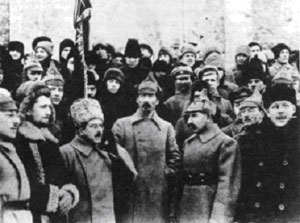
Dzerzhinsky_in_crowd.JPG
Dzerzhinsky (centre) in 1920
There was a popular Soviet camera, FED. The first models were made after Leica. Initially it was produced by a working commune for homeless children named after F.E.Dzierzhynski under the management of the famous Soviet pedagogue, Anton Makarenko. Later the production was expanded to a factory (also named after F.E.Dzierzhynski) in Kharkov, Ukraine.
Dzerzhinsky died of a heart attack in July, 1926. His name and image were widely used throughout the KGB and the Soviet Union—there were six towns named after him. There is a museum dedicated to him in the town of his birth in Belarus. The town itself was renamed Dzyarzhynsk after him to be the capital of the short-lived Polish Autonomous District, or Dzierzynszczyzna, in Belarus. There also is a city of Dzerzhinsk & three cities called Dzerzhinskiy in Russia and two cities in Ukraine called Dzerzhinsk.
Iron Felix also refers to his monument at the Lubyanka Square in Moscow, near the KGB headquarters. Symbolically, the Memorial to the Victims of the Gulag (a simple stone from Solovki) was erected beside the Iron Felix; the latter was removed in August, 1991.
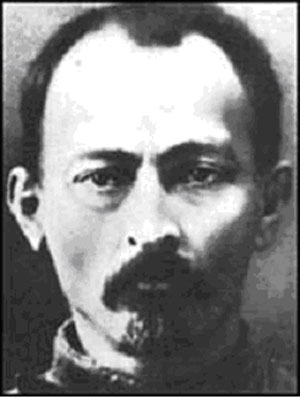
Felix Edmundovich Dzerzhinsky - At 1920
Links Externos
- Figura do calculador Felix (http://www.dotpoint.com/xnumber/pic_felix.htm)
- FED history (http://www.rus-camera.com/history.php?page=fed_factory_history_1)
be:Фэлікс Дзяржынскі
de:Felix Edmundowitsch Dserschinski
fr:F鬩x
Dzerjinski
pl:Feliks Dzierżyński
ru:Дзержинский,
Феликс Эдмундович
Obtido de: "http://www.objectsspace.com/encyclopedia/index.php/Felix_Edmundovich_Dzerzhinsky"
Calculador Felix
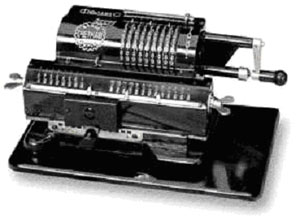 |
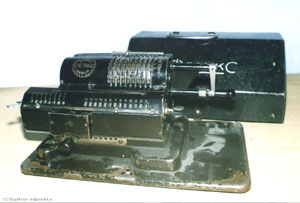 |
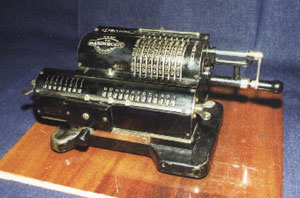 |
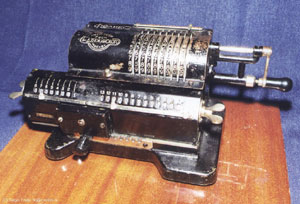 |
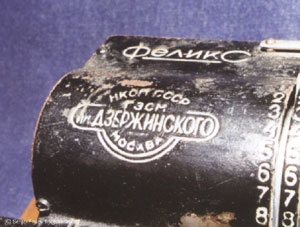 |
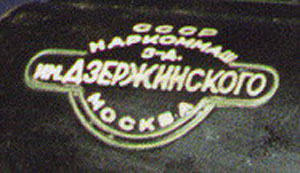 |
Four more images of "Felix" calculator
Images-Courtesy Sergey Frolov
Nos anos 30, e 40, esta maquina de somar de tipo de roda de pinos (aritmometros) tinham seu uso em bancos, contadores e lojas. O progresso nos trouxe os calculadores eletrônicos e os computadores. Poucas maquinas deste tipo sobreviveram. Salvamos algumas e as restauramos em suas condições originais inclusive com as marcas Russas incluindo o ”CCCP”, e as marcas plenamente visíveis do "Felix" de Felix Dherzhinskiye, fundador da Checka (que se transformou na infame KGB) e também nome da fabrica que produziu estas belezinhas. " Sovietski Collection”.
From www.rus-camera.com
Important Dates
FED Factory History (part 1)
|
The story of the firm producing photographic cameras, FED, is closely linked to that of one man, Anton S. Makarenko, a teacher, poet and writer (1888 -1939). The history of the FED working commune is in fact a summary of the post Bolshevik revolution years in the USSR. This joint history is comprehensively described, commented and illustrated in a highly documented study, by Oskar Fricke, published in the "History of Photography". September 1920. First Ukrainian rehabilitation Colony for "young orphans of the revolution" at Poltava under the management of Anton Makarenko. 1925. The Leica-1-appears at the Leipzig fair. 1926. Death of Felix Edmundovich Dzerjinski (born in 1877), founder of the Soviet Secret Police, the "Tcheka" which in the year of his death becomes the OGPU (Confederate State Political Department). The Ukrainian political board decided to create a "working commune for children" in the suburbs of Kharkov and to give it the name of the "'late lamented chief", F. E. Dzerjinski. June 1927. Anton S. Makarenko is "invited" by the Ukrainian police to come and supervise the organization of the completely new Working Commune of F. E. Dzerjinski name. He remains as its director for 8 years. 29th December, 1927. Official creation of the FED Working Commune, made up of 150 girls and boys between the ages of 13 and 17 years supervised by a nucleus of 50 "senior members" from the Gorky Colony. There were to be 300 "Communards", the name they liked to give themselves, in 1932 and 600 in 1935. 1927. Government directives forbidding the importation of foreign materials. 1928. Stalin, with a consolidated power, launches the first five year plan. The objective is to transform an essentially agricultural country into an industrial nation, independent from the "capitalist world". Makarenko's method of education combines productive work with secondary education according to the Marxist principals, which seek to eliminate the distinction between physical work and intellectual work. End of 1929. The working commune has developed several types of craft industry: carpentry, ironwork, cobbling and sewing. The products sell well and the communards receive their first salaries. From September 1930. A group from the Engineering Institute in Kharkov comes and delivers a university program to the worker-students as supplementary education, in response to the Government's directives to take part in the industrial expansion. May-November 1931. Using the profit from their sales and with the help of a state loan, the business takes an active part on the construction of new buildings, on two floors, to be used for the mass production of portable electric drills. January 1932. Inauguration of the buildings. Assembly of the first FD-1 drills, copies of an Austrian Assembly drill. FD, of course for Felix Dzerjinski. June 1932. Two other models of drills, the FD-2 and FD-3, copies of the American Black & Decker are put into production with 11,500 drills planned. April 1932. Launch of the Leica II in Leipzig. June 1932. In parallel with the production of the drills, the construction of a Leica type camera is planned on 2nd June. The code name is F. On 21st June a special research department is established in the commune. On 26th October the first 3 "Soviet Leicas", exact copies of the Leica 1a are assembled. This important news is reported in the official press medium Izvestiya on 5th November. January-February edition of Proletarskoe Foto: the first photo of the first FED model called ... Pioneer appears. 1933. This year is devoted to the planning and preparation of the production of cameras, whilst the production of drills increases. The challenge for the commune is paramount, new techniques and new tools are perfected for the production of the more than 300 necessary parts. Nothing, like this copy of the Leica, has ever been mass produced in the field of optics in the USSR before. A margin of error of less than a micron is demanded of the tools. The polishing of the lens elements requires the highest precision, and if the lenses of the first three models of October 1932 and of the first series, 3.5 anastigmat lenses of 50mm are made by VOOMP, the commune will soon be in a position to produce them, with the help of GOI. New buildings were erected in order to protect the manufacturing department. Plans are made to produce 30,000 cameras per year. Only 30 FED copies of the Leica 1 will be made. To this day, none have reappeared. In January 1934, the production of the FED 1 started, a copy of the Leica II. The first 10 "standard" FED were assembled, numbered from 31 to 40, at the end of January. The FED and the Commune were the subject of a eulogistic report in the April 1934 edition of the magazine "USSR in construction" in which the brand new FED appeared for the first time ("FEDKA" as called by the communards or A. S. Makerenko in his letters to Maxime Gorki). An extraordinary achievement less than 18 months after the presentation of the Leica "Complex" at the fair in Leipzig, the prestigious camera is copied and mass produced by a "group of young lads and lasses" aged about twenty. In July 1934 the state police service is transferred from the OGPU to the NKVD (People's Board for Interior affairs). The engraving "NKVD" appears on the FED covers. (FED 1b) In December 1934 1,800 cameras were delivered (type. 1a). 1935 will be a year of many changes for the commune. In July 1935 Makarenko is transferred to Kiev. In January 1937 he retires to Moscow in order to write, until his death on 1st April, 1939. September, 1935: the 10,000th FED was assembled. November, 1936: the 25,000th FED was assembled. The success of the FED, diversification at the request of the public and the photographic press, additional lenses, accessories, enlargers, projectors, etc... and increase in the number of members of the commune, more than 750, and in addition 400 people from outside, all contributed to a necessary change in the structure. This need for change coincided with a decree dated 4th March 1937 from the Narkompros (People's Board for Education) ordering the abolition of working communes in the USSR. Since the F. E. Dzerjinski commune was not under the jurisdiction of the Narkompros, it was not immediately affected by this, but the era of shared work and education was over. The first accessories appear at the end of 1937, in the form of a photo-electric cell, a strange self-timer with a positioning mirror, and laboratory material. In November 1937 a FED equipped with sportsfinder based very closely on the Leica model is presented in "Sovetskoe Foto". One has to wait until the end of 1938 for the appearance of the additional lenses requested by many: - The wide-angle lens f4.5/28mm and its viewfinder. *- The f2/50mm. *- The f3.5/50mm reproduction. *- The f5.9/100mm and its viewfinder (advised aperture for usage: 6.3 replaced by the f6.3/100mm). |
FED Factory History (part 2)
Announced in 1937, the new model "FED V" only actually appeared in 1938.
Identical to the standard FED it displayed, like the Leica IlIa its model, the slow speeds on the front (1s - 1/20s) and the maximum speed was brought up to 1/1000s. Only 40 copies of the FED V were to be assembled.
The "FED S", fitted with 1/1000s, delivered with the brilliant lens f2/50mm, was to be produced parallel to the "classic" FED, but in small quantities. That same year saw the publication of a manual written by D. Bunimovitch based very closely - on the Leica Handbook. A second edition was to be delivered in 1942.
In 1939, two historical events were reported on the FED covers (FED 1e):
- The Ukraine lost its independence: the engraving NKVD UkSSR became NKVD SSSR, and
- the FED commune became a KOMBINAT, (from the English Combine, and the French Association) an economic structure more in keeping with the industrial complex that the firm had become: the case was engraved likewise.
The 80,000th FED was announced in the January 1939, on edition of Sovietskoe Foto as having been assembled at the very end of 1938.
The 100,000th FED was celebrated by the press in its own turn in the middle of 1939.
In 1939, the total Soviet production of all models exceeded 478,000 cameras of which 34,000 were made at Kharkov.
Slightly more than 175,000 FED were made from 1934 to 1941. (Official figures: in reality certainly more than 180,000 of which a large number, were not assembled in 1941.)
On 22nd June, 1941, breaking the German-Soviet pact, Nazi Germany invaded the USSR. In the face of the German advance, Stalin ordered more than 1,300 businesses to withdraw with all their machinery into the Ural or into Siberia.
From 5th September to 16th October the FED Kombinat was evacuated to Berdsk, 40 kilometers from Novosibirsk.
The staff who had not been called up, under the direction of the chief engineer Gorbunov, did not resume the production of cameras or drills. However, a few hundred cases were assembled using spare parts. The vast majority of the tools, production machines and unassembled cameras never arrived at Berdsk, but were directed towards "another" business. The officials of FED were never to know the destination of their ex-production tools. However a "selection" of FED technicians were secretly delegated to "another place" of Siberian exile…
Under the supervision of the Soviet Air Force, the evacuees from Kharkov were appointed to the tasks of making aircraft parts, carburettors, injection pumps (Lavotchkin LA-5 plane)… etc.
25th October 1941: Kharkov fell to the German troops. The town was all but razed and in the destroyed FED factory, the conquerors were surprised to find copies of "Leica" and "Leitz" microscopes. The archives of the Commune were burnt, only those of the "Party" were cleared out.
After long fierce battles, Kharkov was freed on 23rd August 1943 by the Red Army. Immediately, a number of volunteers, formerly from FED, returned between 1943 and 1945 to Kharkov, a town in ruins.
In June 1945, orders to resume the photographical production arrived in Berdsk.
In January 1946 3 workshops were set aside for this purpose, not without difficulty. It was using bodies and lenses remaining from the evacuation and the experience of a few evacuated workers but with hardly any supervision that the "dzerjinskiens" recreated their equipment. In July 1945 the dimensioned plans were ready and the albeit rather clumsy production and assembly of the first "post-war FED" began. (FED 1e)
A few hundred cameras were made.
During the first quarter of 1946, the 3.5 lenses were produced once again, in spite of the absence of qualified staff. The collective promised to multiply by 5 the rate of production. In June 1946 79% of the production plan was achieved. (Party documents)
6th September, 1945, FED received the Order of the Red Flag for Work (Ordena Troudovogo Knasnogo Znameni) for its heroic conduct during the great patriotic war.
In 1946 the NKVD was reorganized and made subordinate to the MVD. FED abandoned its status of Kombinat and became an independent factory.
July 1946, the decision was made to go back to Kharkov. Already between September 1943 and 1945, some people had returned to Kharkov, with the mission of rebuilding the factory.
From September to November 1946 9 trains coming from Berdsk brought survivors, machine tools and ... a great deal of hope to Kharkov.
In January 1947 the machines were assembled and the factory received the order from the ministry to recommence the production of cameras on a massive scale. This production started properly in March 1947. With the return of the demobbed soldiers the workforce was complete again.
In 1947 the "FED-ZORKI" was put into production in Krasnogorsk near Moscow.
At the beginning of 1948 the factory made 800 sets of production equipment but it was only in June 1948 that with difficulty the first twenty new FED "Kharkov" were assembled. On that occasion the factory resumed the numbering at 200001 (or 200010?).
In December 1948 production reached 300 FED per month. The first 1800 bodies were engraved on the cover with the Order of the Red Flag for Work. (FED Red Flag). The engraving NKVD was replaced by that of NKAP. (People's Board for the Aeronautical Industry.)
At the same time FED made parts of agricultural tractors. 0ut of the 128 different articles in the catalogue, many were made of cast iron or moulded aluminium. These moulding techniques were perfected in detail during the war. The body of the FED 2 was to be the proof of this.
The next series appeared with a redesigned set of initials FED (FED type 1f). The presentation and the finish continued to improve and during 1953 at about the number 400,000 the camera was fitted with 1/25th of a second and a few improvements. (FED type 1g).
1952 saw a crisis, the cameras were not selling so well...
From 1933 to 1941, then from 1946 a 1955, more than 700,000 FED "Leica copies" were made, all the same in appearance if differences in the engraving are excluded.
A development of the FED had already been researched before the great patriotic war, but the plans had disappeared with the equipment in the exodus...
Another successor of the FED 1 was to make its appearance in 1955: the FED 2. By 1970 almost 2 million had been made.
In 1971, the factory became the FED Unit of Mechanical Production. Throughout its history FED had been, and remained, a factory producing popular photographic cameras, which were mainly mechanical and cheap but reliable. All the attempts to break away from this ethos had not been pursued, probably more as a result of the "factory spirit" rather than external factors or technical difficulties.
From 1981 to 1985 the production general manager was called V. P. Makarenko, a famous name there.
In 1991 after the collapse of the USSR, FED became an independent Ukrainian factory.
Anton Makarenko wrote in 1936:
"and perhaps the FED will be better known than the Dzerjinski commune"
FED Factory History (part 3)
The first 35mm cases with a 39 screw mount assembled in Moscow, at the end of 1947, beginning of 1948, with the collaboration of engineers seconded from FED, are FED's. During those years, in the spirit of Soviet photography, the local Leica was called FED, so not wishing to usurp deliberately, the name FED vas engraved on the camera above the KMZ logo. However, Gavrilov's team made rapid progress on the camera and right at the beginning of 1948 the engraving had the name ZORKI added to it. A new great copy of the Leica was born.
FED-KMZ 1948
Designer: N. A. Gavrilov.
Pilot production of the FED-ZORKI. The first FED cameras assembled in
Krasnogorsk. The shutter has a maximum speed of 1/1000 sec.
FED-ZORKI 1948
About 5,500 copies were made
Production started still using original FED parts. Gradually the sub-sets are
made in Krasnogorsk. The same goes for the lenses for within a few months the BK
and ZK lenses of Zeis origin have been used up and replaced by ones made
locally. On these lenses the engraving ZORKI comes before the KMZ sign.
K30 - The case is a FED-1 type-d, same covering, same mat chromium plated finish, same interior finish.
The lens (K330) is an lndustar-22 FED with the N° stuck on the back of the focusing ring "like the FED".
The front is made of aluminium engraved with "Moscow" and the KMZ sign. The lens is uncoated, the apertures standardised, the finish mediocre.
K40 - The cases already foreshadows the ZORKI with its "grain of rice" covering, a finer chrome plating and the base plate of the shutter is painted. Finer engravings on the speed dial.
The lens 2/5cm -1948 is a ZK (Sonnar-Krasnogorsk) telescopic aluminium mount. (K500)
K45 - The case resembles that of the ZORKI, shiny chrome, a better finish.
The lens (K340) is a coated lndustar-22, with the KMZ logo on the front. Is on the back like K330, but engraved.
Variations:
K31 - K41 - K46 / With 1/1000 sec.
FED Factory History (part 4)
February 1942 is the official year of birth of the KMZ factory. The year 1992 thus gave KMZ the opportunity to produce several commemorative cameras.
It was actually 1941 that saw the beginning of what was to become one of the worlds most important manufacturing, units of optical mechanical equipment.
The "Optical Products" workshop was formed by ministerial decision, as a result of the restructuring of several former workshops in Moscow, with their engineers and semi-skilled workers. Amongst them, formerly from the firm EFTE, was E.V.Soloviev who became the chief engineer-project manager of the KMZ factory in about 1959 and designed the FT1, FT3 and Horizont.
A former earthenware factory situated at Krasnogorsk, (from Russian - the "pretty hill" or the "red hill"), in the western suburbs of Moscow was to house the new workshop.
On 22nd June, 1941, in breach of the German-Russian pact, the Nazi troops invaded the USSR. Within a few weeks the Germans were at the gates of Moscow and the Wehrmacht motorcyclists on the Volokolamka highway could make out the Kremlin through their binoculars.
The German army would not advance from this spot, near... Krasnogorsk.
November 1941, the battle of Moscow. At the beginning of December the Soviets launched a counter-attack and the Germans retreated to 250km away.
From the spring the "Optical Products" workshops were evacuated as were more than 1,300 firms of the Russian industrial fabric into the Ural and Siberia.
The firm was evacuated to the suburbs of Sverdlovsk.
Throughout 1942 the German threat no longer hung over Moscow. Several firms, including the workshop, were recalled. It was probably at this time that it became KMZ, Krasnogorski Mekhanicheskii Zavod - Mechanical Engineering Factory of Krasnogorsk - with, as its logo, a single prism that the factory's workforce soon nicknamed "the tomb".
The forces desperately needed optical equipment, binoculars, rangefinders, sights, etc… Leningrad was under siege, neither GOMZ nor GOI could supply the army. FED in Berdsk was producing aircraft parts. It fell to KMZ to take the military orders.
Let us remember that in June 1945 the Soviet Union had three seats at the United Nations: Russia, the Ukraine and Belorussia.
In the geopolitical hope of making people, especially in the West, believe in the relative autonomy of the republics, Stalin supported the establishment of "status-enhancing" firms in the capitals of these republics.
Civil optics was one such sector.
Hence the creation of KIEV-ARSENAL in the Ukraine as a manufacturer in 1946, then MlNSK-MMZ in Belorussia in 1957.
1946. The KMZ factory was soon ready to start production. The enthusiasm of the workers, especially the female workforce was quite remarkable. The help from the Germans was invaluable.
The first cameras to be supplied were the MOSKVA 1, in fact the firsts were Zeiss Nettars just assembled in Krasnogorsk, then the MOSKVA 2, Soviet Super Ikontas. With the help of equipment of FED origin, KMZ presented the first FED-KMZ at the beginning of 1948, then FED-ZORKI.
Right from the outset the engineers and fitters endeavored to produce a camera with a perfect finish.
In 1949 the design-group made up of Gavriov, Denisov and Korolkov finalized a new release mechanism on the case.
The ZORKI had just been born.
If one: included all the ZORKI models, more than 4.5 million cameras were to be made and delivered, and more than 6 million basic lenses, Industar-22 and Industar-50, Jupiter-8 and Jupiter-3.
From 1950 to 1960 production levels increased and the range of lenses complemented the original "Zeiss" lens. KMZ supplied, as well as the mounts for its own cases, the 39 screw-mount lenses for the GOMZ LENINGRAD cameras and bayonet mount lenses for the KIEV ARSENAL cameras.
From 1955 KIEV produced its own lenses.
In 1956 the millionth Industar lens was assembled.